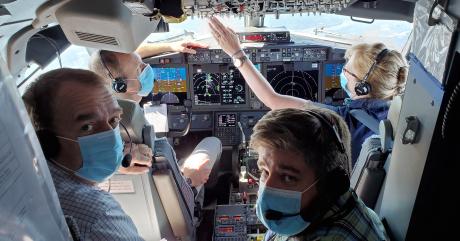
EASA has completed Boeing 737 MAX flight testing, clearing the way for joint regulatory agency evaluations of the grounded model’s updated training later in September.
EASA’s work took place in Vancouver, Canada aboard Boeing’s 737-7 development aircraft 1E001.
“As the next step in its evaluation of the aircraft for return to service, EASA is now analyzing the data and other information gathered during the flights in preparation for the Joint Operations Evaluation Board (JOEB),” the European agency said Sept. 11.
The JOEB includes participation from Brazilian, Canadian, European, and U.S. pilots and regulators and is set to start Sept. 14 at London Gatwick Airport and last about 10 days. The board will evaluate proposed MAX training for pilots and feed an FAA-led Flight Standardization Board (FSB) report that will establish minimum training curriculum.
EASA did not release any details of the flights. Flightradar24 tracking data show that 1E001 conducted one, 2 hr. 27 min. flight that started and ended at Vancouver International Airport on Sept. 10. The flight profile included a series of tight turns and several altitude changes that would be consistent with trialing the MAX’s updated flight control computer (FCC) software. Boeing modified the software, including the maneuvering characteristics augmentation system flight control law, based in part on lessons learned from two fatal accidents that led to the model’s global grounding 18 months ago.
The FAA has been the lead regulatory agency working with Boeing on needed changes to the MAX. But several other regulators, including EASA and Transport Canada, have said they will conduct their own reviews. EASA’s test flights and a series completed last month by the Canadian regulator are part of this process.
“EASA has been working steadily, in close cooperation with the FAA and Boeing, to return the Boeing 737 MAX aircraft to service as soon as possible, but only once we are convinced it is safe,” the European regulator said.
Among the key steps left before regulators approve the MAX beyond the JOEB and FSB is finalizing an airworthiness directive (AD) detailing required steps for operators. The FAA issued a draft AD in August outlining the main steps, which include installing Boeing’s updated FCC software, modifying wiring bundles deemed to be too close together, and putting all MAX pilots through revised training. The directive is in the midst of a public comment period that runs through Sept. 21.
The draft AD has garnered 130 comments so far, mainly from people who say they are not in aviation but have an interest in the MAX because they travel. Many commenters say the proposed changes are not enough to convince them to fly on a MAX.
Among the few comments that include technical analysis or suggested additions to the proposed changes is a Joint European Max Operators Group (JEMOG) proposal to further modify the Airspeed Unreliable quick reference handbook (QRH) checklist—one of several that Boeing has proposed changing.
“Due to the revised QRH checklist sequence for Airspeed Unreliable, we recommend a caution statement should be added above the autopilot engagement instruction,” said the group, which represents 10 European MAX customers, including Norwegian, Ryanair, Smartwings and TUI. “The purpose of this statement will be to highlight to crew the risk of autopilot engagement while erroneous indications persist.”
The JEMOG’s proposed QRH addition: “After autopilot engagement verify that aircraft flight path including pitch, roll and airspeed are responding as intended.”
Comments on the draft AD will be reviewed and considered as the FAA prepares the final directive. The U.S. agency’s return-to-service plan does not include a time line. Boeing remains cautiously optimistic that initial regulatory approvals will come before year-end, but the company emphasizes that regulators are driving the process, and each agency will make its own decision on when to clear the MAX for revenue service in its airspace.
Even if the FAA and other agencies clear the MAX to fly again later in 2020, its return to revenue service in 2020 remains doubtful. Issuance of a final AD starts weeks of work for operators before they can put MAXs into their operations. Among the tasks facing airlines once MAXs are cleared: installing software on each aircraft, flight and maintenance manual updates and related approvals, pilot training, as well as integrating the models back into their networks and reservations systems.





